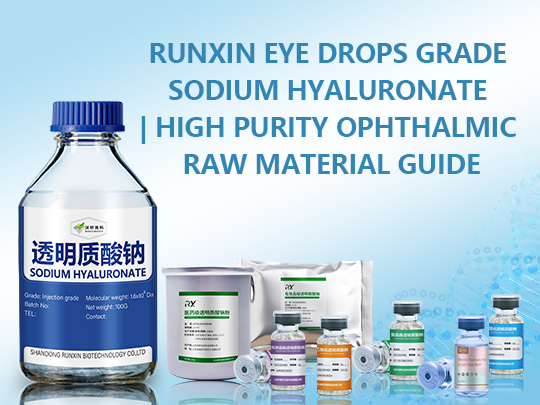Introduction
With 28 years of pharmaceutical-grade manufacturing expertise, Runxin presents Eye Drops Grade Sodium Hyaluronate—a supremely pure raw material specifically designed for ophthalmic applications. This comprehensive guide addresses critical formulation challenges while providing expert solutions for developing safe, effective eye care products.
Technical Specifications & Advantages
Ultra-low endotoxin levels for ocular safety
Precisely controlled molecular weight distribution
Exceptional clarity and viscosity characteristics
Compliance with international pharmacopoeia standards

Critical Application Guidelines
1. Sterility Assurance & Preservation
2. Ocular Comfort Optimization
3. pH & Osmolarity Precision
4. Packaging Compatibility
Quality & Compliance Standards
Pharmaceutical-Grade Manufacturing: cGMP compliant facilities
Rigorous Testing Protocol: Full USP <71> sterility testing
Documentation Support: Complete regulatory support packages
Batch Consistency: Guaranteed purity and performance parameters
5 Google-Optimized Q&A About Eye Drops Grade Sodium Hyaluronate
Q1: What makes eye drops grade sodium hyaluronate different from cosmetic grade?
A: Eye drops grade requires ultra-low endotoxin levels (<0.05 EU/mg), strict sterility assurance, and compliance with pharmacopoeia standards, making it suitable for sensitive ophthalmic applications.
Q2: What concentration range is optimal for eye drop formulations?
A: Typically 0.1%-0.3%, balancing comfort with effective lubrication. The exact concentration depends on desired viscosity and residence time.
Q3: How do you ensure sterility in eye drops grade sodium hyaluronate?
A: Through aseptic manufacturing processes, terminal sterilization validation, and comprehensive microbial testing following USP <71> standards.
Q4: Can eye drops grade HA be used in multi-dose preservative-free systems?
A: Yes, when combined with advanced packaging technologies that maintain sterility throughout product use, such as ABAK® or COMOD® systems.
Q5: What supporting documentation does Runxin provide for regulatory submissions?
A: We provide full regulatory support packages including Certificate of Analysis, Drug Master File, and compliance with USP/EP/JP standards.
Recommended Applications
Lubricating Eye Drops: Dry eye syndrome management
Post-Surgical Formulations: Corneal protection and healing
Contact Lens Solutions: Enhanced comfort and wettability
Ophthalmic Gels: Extended residence time applications
Technical Support Services
Formulation development assistance
Sterilization process validation
Regulatory submission support
Stability study design and monitoring
Conclusion
Runxin's Eye Drops Grade Sodium Hyaluronate offers pharmaceutical manufacturers a reliable, high-quality raw material for developing advanced ophthalmic products. Our 28 years of expertise ensures compliance with the highest international standards for safety and efficacy.
Contact Runxin for technical documentation, samples, and regulatory support services.



